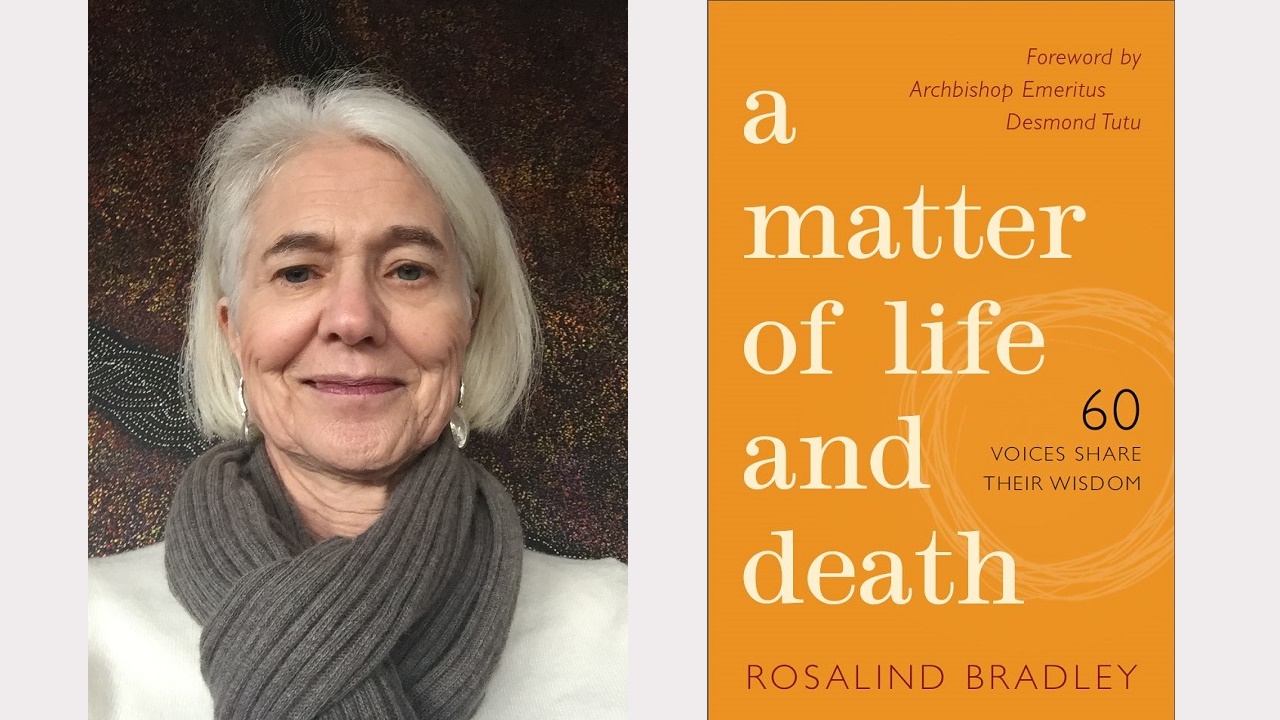Book review - A Matter of Life and Death: 60 voices share their wisdom
Book review - A Matter of Life and Death: 60 voices share their wisdom
by Melissa Cumming
Tuesday, May 30, 2017
Melissa Cumming is a member of the Palliative Care NSW Management Committee. Her book review was first published in the autumn edition of Pallium, the official newsletter of Palliative Care NSW.
I recently had the opportunity to meet with Rosalind (Ros) Bradley, author of A Matter of Life and Death: 60 voices share their wisdom. The book is a compilation of reflections and narratives by people from various countries and backgrounds sharing their wisdom and perspectives on death. Yet as the title suggests, the reflections are as much about life, as death.

Meeting in a Sydney café for a cup of tea, I found Ros to be a petite, friendly and gentle lady. Born in the UK but resident in Sydney for more than 30 years and with a work-life centred around people and volunteering, Ros found herself pondering the existential aspects of life and death after her mother died suddenly during a visit to Sydney.
For Ros those few days, just after September 11, were profound: “One day we were walking past the Opera House, and the next day she had a cardiac arrest and died”.
With emotion gently cushioning her words, Ros spoke about her anxious time in the emergency department waiting room as staff tried to revive her mother, and then being taken to a room the size of a broom cupboard to view her mother after she had died.
Her mother was the first deceased person she had seen. For three years after her mother’s death, Ros experienced physical symptoms that she now relates to her grief. The death of two friends a few years later fuelled her need to further explore and question the meaning of life and death.
As the author of two previous books, this search for answers led Ros to invite 60 people to share their experiences and views about death. With a forward penned by Archbishop Desmond Tutu, the book is in five parts: Personal Encounters with Death; Death Brings us Wisdom; Working Closely with Death; Death and the Circle of Life; and Death is Sacred.
This final chapter presents views from a multi-faith and multicultural perspective. The contributors come from diverse backgrounds, and as Ros suggests, “all have their own take on death” but share the common experience of death as part of their life’s canvas.
Lay people, artists, coroners, funeral directors, intensivists, palliative care workers, counsellors, spiritual leaders, a midwife, a soldier, a Holocaust survivor and a death row inmate to name a few, have all provided their insights on the mystery but inevitability of death.
In a creative and rather comforting approach, Ros invited each person to contribute a passage or image that was significant about what death means to them, and then provide a reflection on that piece from their own experience or from their spiritual base. The reflections are insightful, sensitive and thought-provoking. A short bio follows each contribution.
Olga, a Holocaust survivor whose mother died moments after they were registered as survivors from a war camp, speaks of her despair at witnessing so much death and then her guilt at surviving. She now teaches others to care for Holocaust survivors in nursing homes.
Sydney’s very own Dr Frank Brennan, a palliative care physician, narrates a poignant story of a young man facing his own death a few months after his father died, and the family’s struggle with compounded grief.
A French Trappist monk captured and murdered in 1996 during the Algerian Civil War recorded his final testament before his untimely death, and his views about life and his prophesized death are included.
Ros hopes that these reflections might “help dispel some of the fears that surround death and dying and … encourage us to speak out more about this often avoided and delicate subject”.
As a palliative care health professional for more than 30 years I believe this book is relevant and timely as our society slowly but increasingly engages in conversations about dying. And as an avid reader with a love of prose, I found Ros’ use of verse and narrative non-threatening, easy to read and comforting despite the traditionally taboo subject matter. (“I am not afraid of death. I know so many people there”: Amy, eight-year-old Norwegian girl.)
In offering different perspectives on death the narratives will resonate with most audiences and allow the reader to further explore their own beliefs at a time and pace that suits them. More broadly the text has enormous potential as a teaching tool; for professionals (health and non-health sector), volunteers, students and those providing counsel to the dying or bereaved. Its value may be in its use as a prompt for individual or group discussion, or through use as a template for a similar approach to creative writing about death.
As time grew short and our cups empty I asked Ros if she found the answers for which she was searching. What messages did she find in the writings of her contributors? Without hesitation, she replied, “Death is part of life, don’t live with regrets, be more authentic in our lives and relationships, say ‘I love you’ more often and live in the present”. Not surprisingly, Ros’ messages have more to do with life than death. Maybe that is what matters?
“For life and death are one, even as the river and the sea are one”: Kahlil Gibran, The Prophet.
A Matter of Life and Death: 60 voices share their wisdom can be purchased from most leading bookstores or at www.footprint.com.au All royalties from the book go to Ashgate Hospicecare in the UK where Ros’ dear friend Deborah died in 2008.
Author: Rosalind Bradley Jessica Kingsley Publishers, UK. 1st Edition 2016, 232 Pages ISBN 978 1 84905 601 4
